英语口语教学Food主题
- 格式:ppt
- 大小:4.74 MB
- 文档页数:36
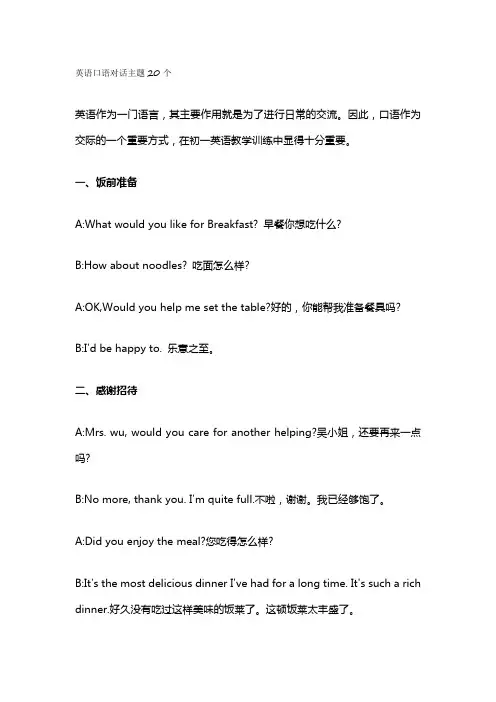
英语口语对话主题20个英语作为一门语言,其主要作用就是为了进行日常的交流。
因此,口语作为交际的一个重要方式,在初一英语教学训练中显得十分重要。
一、饭前准备A:What would you like for Breakfast? 早餐你想吃什么?B:How about noodles? 吃面怎么样?A:OK,Would you help me set the table?好的,你能帮我准备餐具吗?B:I'd be happy to. 乐意之至。
二、感谢招待A:Mrs. wu, would you care for another helping?吴小姐,还要再来一点吗?B:No more, thank you. I'm quite full.不啦,谢谢。
我已经够饱了。
A:Did you enjoy the meal?您吃得怎么样?B:It's the most delicious dinner I've had for a long time. It's such a rich dinner.好久没有吃过这样美味的饭莱了。
这顿饭莱太丰盛了。
A:I'm so glad you like it.你能喜欢,我不胜荣幸。
B:Thank you very much for your hospitality.谢谢你的盛情款待。
三、英文问路指路A: Excuse me, Where am I on this map?对不起,请问我在地图上的什么地方?B: We are here, bus station, we are in the heart of the city.我们在这里,汽车站,我们现在在市中心。
A: Oh ! I think I ’m lost. Can I go from here to the railway station?哦!我想我迷路了。
我能否从这里到火车站呢?B: Head straight up the street about two blocks then turn left.顺这条街一直走过两个街区,然后左转。
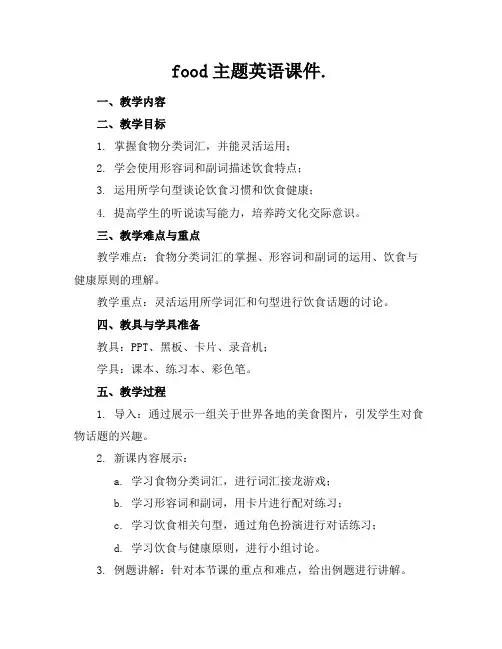
food主题英语课件.一、教学内容二、教学目标1. 掌握食物分类词汇,并能灵活运用;2. 学会使用形容词和副词描述饮食特点;3. 运用所学句型谈论饮食习惯和饮食健康;4. 提高学生的听说读写能力,培养跨文化交际意识。
三、教学难点与重点教学难点:食物分类词汇的掌握、形容词和副词的运用、饮食与健康原则的理解。
教学重点:灵活运用所学词汇和句型进行饮食话题的讨论。
四、教具与学具准备教具:PPT、黑板、卡片、录音机;学具:课本、练习本、彩色笔。
五、教学过程1. 导入:通过展示一组关于世界各地的美食图片,引发学生对食物话题的兴趣。
2. 新课内容展示:a. 学习食物分类词汇,进行词汇接龙游戏;b. 学习形容词和副词,用卡片进行配对练习;c. 学习饮食相关句型,通过角色扮演进行对话练习;d. 学习饮食与健康原则,进行小组讨论。
3. 例题讲解:针对本节课的重点和难点,给出例题进行讲解。
4. 随堂练习:让学生根据所学内容,进行听力、口语、阅读和写作练习。
六、板书设计1. 食物分类词汇;2. 形容词和副词;3. 饮食相关句型;4. 饮食与健康原则。
七、作业设计1. 作业题目:以小组为单位,编写一段关于饮食与健康话题的对话。
2. 答案:略。
八、课后反思及拓展延伸2. 拓展延伸:鼓励学生课后收集更多关于食物和饮食健康的资料,进行课堂分享,提高学生的跨文化交际能力。
同时,组织学生参加有关美食制作的实践活动,使学生在实践中掌握所学知识。
重点和难点解析1. 教学内容的难点与重点;2. 教学过程中的新课内容展示;3. 作业设计;4. 课后反思及拓展延伸。
一、教学内容的难点与重点教学难点:食物分类词汇的掌握、形容词和副词的运用、饮食与健康原则的理解。
补充说明:1. 食物分类词汇的掌握:为学生提供一份食物分类词汇表,包含各种食物的名称,如水果、蔬菜、肉类、海鲜等。
在教学过程中,通过词汇接龙、卡片配对等游戏形式,帮助学生记忆和巩固这些词汇。

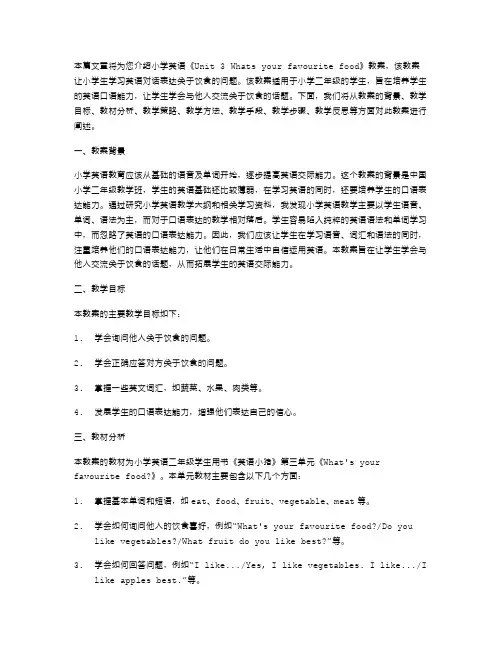
本篇文章将为您介绍小学英语《Unit 3 Whats your favourite food》教案,该教案让小学生学习英语对话表达关于饮食的问题。
该教案适用于小学二年级的学生,旨在培养学生的英语口语能力,让学生学会与他人交流关于饮食的话题。
下面,我们将从教案的背景、教学目标、教材分析、教学策略、教学方法、教学手段、教学步骤、教学反思等方面对此教案进行阐述。
一、教案背景小学英语教育应该从基础的语音及单词开始,逐步提高英语交际能力。
这个教案的背景是中国小学二年级教学班,学生的英语基础还比较薄弱,在学习英语的同时,还要培养学生的口语表达能力。
通过研究小学英语教学大纲和相关学习资料,我发现小学英语教学主要以学生语音、单词、语法为主,而对于口语表达的教学相对落后。
学生容易陷入纯粹的英语语法和单词学习中,而忽略了英语的口语表达能力。
因此,我们应该让学生在学习语音、词汇和语法的同时,注重培养他们的口语表达能力,让他们在日常生活中自信运用英语。
本教案旨在让学生学会与他人交流关于饮食的话题,从而拓展学生的英语交际能力。
二、教学目标本教案的主要教学目标如下:1.学会询问他人关于饮食的问题。
2.学会正确应答对方关于饮食的问题。
3.掌握一些英文词汇,如蔬菜、水果、肉类等。
4.发展学生的口语表达能力,增强他们表达自己的信心。
三、教材分析本教案的教材为小学英语二年级学生用书《英语小猪》第三单元《What's yourfavourite food?》。
本单元教材主要包含以下几个方面:1.掌握基本单词和短语,如eat、food、fruit、vegetable、meat等。
2.学会如何询问他人的饮食喜好,例如“What's your favourite food?/Do youlike vegetables?/Wha t fruit do you like best?”等。
3.学会如何回答问题,例如“I like.../Yes, I like vegetables. I like.../Ilike apples best.”等。

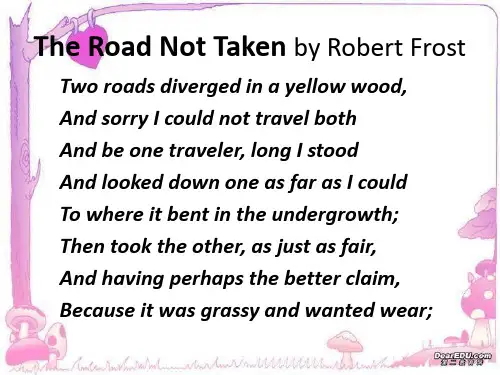
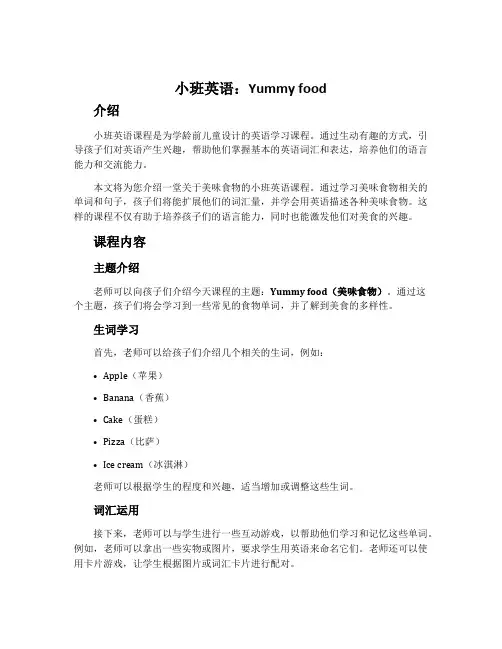
小班英语:Yummy food介绍小班英语课程是为学龄前儿童设计的英语学习课程。
通过生动有趣的方式,引导孩子们对英语产生兴趣,帮助他们掌握基本的英语词汇和表达,培养他们的语言能力和交流能力。
本文将为您介绍一堂关于美味食物的小班英语课程。
通过学习美味食物相关的单词和句子,孩子们将能扩展他们的词汇量,并学会用英语描述各种美味食物。
这样的课程不仅有助于培养孩子们的语言能力,同时也能激发他们对美食的兴趣。
课程内容主题介绍老师可以向孩子们介绍今天课程的主题:Yummy food(美味食物)。
通过这个主题,孩子们将会学习到一些常见的食物单词,并了解到美食的多样性。
生词学习首先,老师可以给孩子们介绍几个相关的生词,例如:•Apple(苹果)•Banana(香蕉)•Cake(蛋糕)•Pizza(比萨)•Ice cream(冰淇淋)老师可以根据学生的程度和兴趣,适当增加或调整这些生词。
词汇运用接下来,老师可以与学生进行一些互动游戏,以帮助他们学习和记忆这些单词。
例如,老师可以拿出一些实物或图片,要求学生用英语来命名它们。
老师还可以使用卡片游戏,让学生根据图片或词汇卡片进行配对。
句子构造在学生掌握了基本的食物单词后,老师可以引导他们学习如何用这些单词构造简单的句子。
例如,老师可以提问:“What do you like to eat?”(你喜欢吃什么?)学生可以回答:“I like to eat pizza.”(我喜欢吃比萨。
)这样的练习可以帮助学生提高他们的口语表达能力。
绘画活动为了加深学生对美味食物的印象,老师可以组织一个绘画活动。
每个学生可以选择自己喜欢的食物,然后用颜色和形状将其绘制出来。
学生还可以尝试在他们的绘画作品上写上食物的名字。
故事时间最后,老师可以讲述一些与美味食物相关的故事。
例如,可以讲述一个小朋友去冰淇淋店买冰淇淋的故事。
通过故事的讲述,孩子们能够更好地理解和运用他们所学到的词汇和句子。
总结通过这堂关于美味食物的小班英语课程,孩子们可以扩展他们的词汇量,学会用英语表达他们对美食的喜爱和口味的描述。
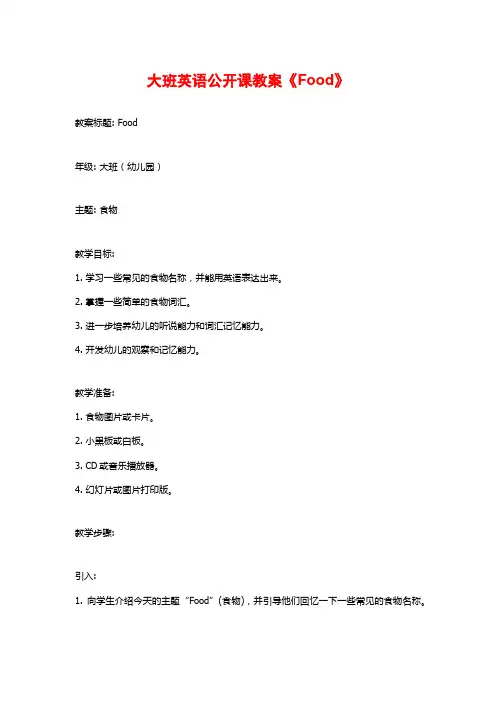
大班英语公开课教案《Food》
教案标题: Food
年级: 大班(幼儿园)
主题: 食物
教学目标:
1. 学习一些常见的食物名称,并能用英语表达出来。
2. 掌握一些简单的食物词汇。
3. 进一步培养幼儿的听说能力和词汇记忆能力。
4. 开发幼儿的观察和记忆能力。
教学准备:
1. 食物图片或卡片。
2. 小黑板或白板。
3. CD或音乐播放器。
4. 幻灯片或图片打印版。
教学步骤:
引入:
1. 向学生介绍今天的主题“Food”(食物),并引导他们回忆一下一些常见的食物名称。
2. 准备一些食物的图片或卡片,并展示给学生看。
询问他们课堂上已经学过的食物名称,并鼓励他们用英语回答。
讲解新词:
1. 利用图片或卡片展示一些新的食物词汇,例如: apple (苹果), banana (香蕉), bread (面包), cake (蛋糕)等。
2. 模仿发音并示范给学生听,让学生跟随发音。
歌曲:
1. 播放一首关于食物的英文歌曲,例如: \。
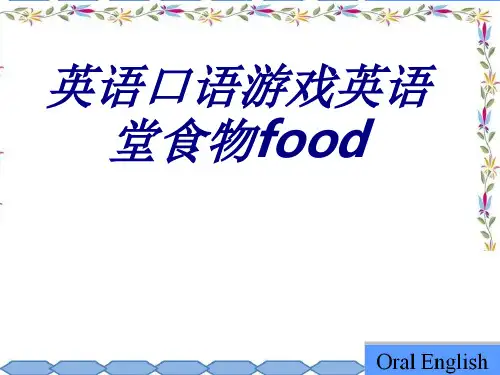
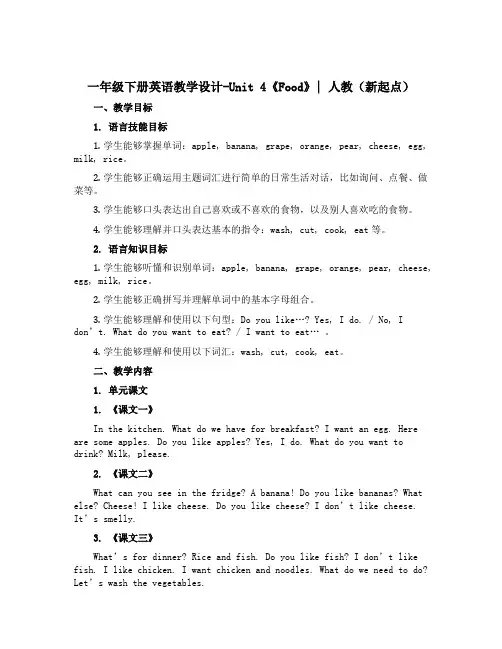
一年级下册英语教学设计-Unit 4《Food》| 人教(新起点)一、教学目标1. 语言技能目标1.学生能够掌握单词:apple, banana, grape, orange, pear, cheese, egg, milk, rice。
2.学生能够正确运用主题词汇进行简单的日常生活对话,比如询问、点餐、做菜等。
3.学生能够口头表达出自己喜欢或不喜欢的食物,以及别人喜欢吃的食物。
4.学生能够理解并口头表达基本的指令:wash, cut, cook, eat等。
2. 语言知识目标1.学生能够听懂和识别单词:apple, banana, grape, orange, pear, cheese, egg, milk, rice。
2.学生能够正确拼写并理解单词中的基本字母组合。
3.学生能够理解和使用以下句型:Do you like…? Yes, I do. / No, Idon’t. What do you want to eat? / I want to eat… 。
4.学生能够理解和使用以下词汇:wash, cut, cook, eat。
二、教学内容1. 单元课文1. 《课文一》In the kitchen. What do we have for breakfast? I want an egg. Here are some apples. Do you like apples? Yes, I do. What do you want to drink? Milk, please.2. 《课文二》What can you see in the fridge? A banana! Do you like bananas? What else? Cheese! I like chee se. Do you like cheese? I don’t like cheese. It’s smelly.3. 《课文三》What’s for dinner? Rice and fish. Do you like fish? I don’t like fish. I like chicken. I want chicken and noodles. What do we need to do? Let’s wash the vegetables.2. 教学活动1. 单词练习a.学生认真听读单词,边读边跟随老师音调大声复读单词。
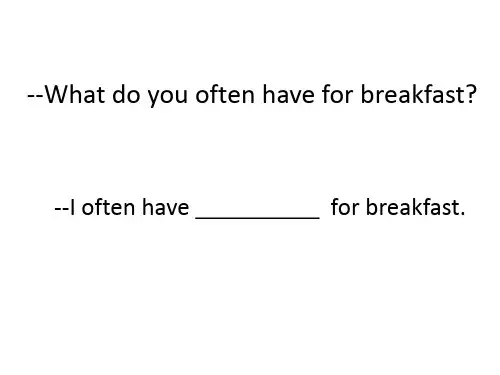
启蒙英语食物教案中班Unit 1: Introduction to Food。
Lesson 1: Learning about Different Types of Food。
Objective: By the end of the lesson, students will be able to identify and name different types of food.Introduction:Hello, class! Today, we are going to start our journey into the world of food. Food is something that we all need to survive, and it comes in many different forms and flavors. In this lesson, we will learn about the different types of food and how they can be categorized.Vocabulary:Before we start, let's learn some new words related to food:1. Fruits: apples, bananas, oranges, strawberries。
2. Vegetables: carrots, broccoli, spinach, potatoes。
3. Protein: chicken, fish, eggs, beans。
4. Dairy: milk, cheese, yogurt。
5. Grains: bread, rice, pasta, oatmeal。
Now that we have learned some new words, let's move on to the next activity.Activity 1: Food Sorting。
大班英语公开课教案《Food》大班英语公开课教案《Food》精选4篇(一)公开课主题:Food教学目标:1. 使学生能够掌握与食物有关的词汇,如水果、蔬菜、肉类等;2. 培养学生的听说能力,能够用简单的句子交流关于食物的信息;3. 培养学生的观察力和合作意识,通过分组合作完成食物分类任务;4. 培养学生的创造力,能够描述不同食物的味道和形状。
教学重点:1. 与食物有关的词汇;2. 用简单的句子交流关于食物的信息。
教学难点:1. 利用所学词汇描述食物的味道和形状;2. 学生之间的合作交流能力。
教学准备:1. 食物的图片或卡片;2. 食物的名称卡片;3. 形容食物味道的词汇卡片。
教学过程:Step 1:Warm-up1. 老师出示一些食物的图片或卡片,问学生他们最喜欢吃什么食物,并给出理由。
2. 随后,老师引入今天的主题:Food(食物)。
Step 2:Vocabulary1. 老师出示食物的名称卡片,一个个读出来并让学生复述。
2. 学生分组合作,看图片或卡片,给出对应食物的名称。
3. 老师辅导学生正确发音并进行纠正。
Step 3:Listening practice1. 老师播放食物名称的录音,并让学生根据录音内容正确配对图片和名称。
2. 学生之间进行校对,检查答案的准确性。
Step 4:Speaking practice1. 老师给每个学生发一张形容食物味道的词汇卡片,比如sweet(甜的)、spicy(辣的)、sour(酸的)等。
2. 学生和同组的伙伴合作,描述自己手中的食物的味道。
3. 学生在小组内互相交流,并选择一个代表向全班展示自己描述的食物和味道。
Step 5:Group work1. 老师将食物的图片或卡片分发给学生,要求学生按照一定的分类标准,将食物分组。
2. 学生之间进行合作,讨论怎样分类更合理,并给出理由。
3. 学生将自己的分类结果展示给全班,并对其他组的分类方法提出自己的看法。
朗文少儿英语口语教学A World Of Food丰富的食物导语:食物是指能够满足机体正常生理和生化能量需求,并能延续正常寿命的物质。
下面带来关于丰富的食物的朗文口语教学,欢迎大家前来学习。
It's called food,glorious food.它被称作食物,美味的食物。
"Food,Glourious Food"“食物,美食。
”Breakfast was great this morning,and lunch wassuper,too.今天的早饭很棒,中饭也不错。
I can't wait to eat my dinner.我迫不及待的想吃晚饭了。
I love to eat food.我喜欢吃东西。
Don't you?你呢?For breakfast I like milk and fruit,an egg with toast and jam.早饭,我喜欢牛奶、水果、鸡蛋、切片面包和果酱。
Or maybe I'll have some cereal,or bread with tomato and ham.或者来一些麦片或夹着番茄和火腿的面包。
For lunch I often have soup,and sometimes asandwich,too.中饭我通常吃一些汤,有时候是一个三明治。
Or a salad with lettuce and onions,anything good will do.或者来一些有生菜洋葱和其他东西的沙拉。
For dinner I like some vegetables,and chicken on my plate,晚饭我喜欢蔬菜和鸡肉,or maybe fish and lots of rice.或者鱼肉和很多米饭。
And cake for dessert is great!有做甜点也是不错的!Do you remember what to do next?你还记得下一步应该做什么吗?Right,it's your turn to sing the song.对,轮到你来唱了。
Favorite Foods最爱的食物(朗文少儿英语口语教学)导语:相信大家都有自己最喜欢吃的食物,下面是关于最喜欢的食物的英语口语教学,欢送大家来学习。
Yum,yum!好吃,好吃!I like orange juice and apple juice,too.我喜欢橙汁,也喜欢苹果汁。
I like fruit juice. How about you?我喜欢果汁饮料,你喜欢吗?Yum, yum!好吃,好吃!I like carrots and tomatoes,too.我喜欢胡萝卜,也喜欢西红柿。
I like vegetables. How about you?我喜欢蔬菜,你喜欢吗?Yum, yum!好吃,好吃!I like chicken and hamburgers,too.我喜欢鸡肉,也喜欢汉堡包。
I like meat. How about you?我喜欢吃肉,你喜欢吗?Yum, yum!好吃,好吃!I like ice cream and chocolate cake, too.我喜欢冰淇淋,也喜欢巧克力。
I like desserts. How about you?我喜欢吃甜食,你喜欢吗?It’s your turn to sing now, ready?现在轮到你们来唱,准备好了吗?The show today is about food, and I really like food. I love food. Let’s listen to the song about food.今天的节目是关于食物的,我真的很喜欢食物。
我爱食物。
让我们听听关于食物的歌吧。
It’s shopping day at Theo’s house. Theo is on packing the groceries. There is lots of food and Nick is helping Theo.这是Theo家的购物日。
英语口语话题:美味的家乡小吃Aside from its more well-known cuisines, China is also home to a colorful street-food(街头小吃) culture. Streetfood is usually served in night markets, always cheap and tasty. Recently, a chart showing a ranking of the best street snack cities of China began circulating online. The chart considers major Chinese cities known for their snack foods based on variety, uniqueness, popularity within China and in foreign countries, innovation, service environment, and a few other criteria.话题:What's delicious snacks in your hometown(家乡的小吃)?范例1:Most Cantonese are fond of and eager for food. Teas inthe morning, afternoon and evening are indispensable tolocals daily life in Guangzhou. At tea time snacks are most important. The kinds of snacks are so various that peopledon't get fed up with them. Cantonese often find it difficult to have satisfactory food between meals when being outside Guangdong, as they are too acquainted with delicious Cantonese food.OK, let's consider some of the great snacks available.Now, let me introduce some delicious Cantonese food to you.The porridge is a unique cuisine you can only find in Guangzhou. Originally the porridge took fresh river shrimpand fillet as the ingredients. Later, jellyfish, fried peanut kernel, shallot, ginger etc. were also included on the list. The rice is boiled with all the ingredients together just before it is served. The porridge tastes fresh and sweet, very delicious. Whether in the restaurants, on the streets or in the White Swan Hotel, the taste is great.Steamed rice roll, which was invented in Pantang in the 1940s. The rice slurry is put into a bamboo steamer or cloth to be steamed until it becomes thin and flat. Next, meat, fillet, shelled fresh shrimps etc. are and cut into pieces and rolled inside before serving. Yinji is the most famous restaurant for offering the delicious soy sauce beef vermicelli roll.范例2:With the reputation of Gourmet Paradise, Hong Kong offers the exotic fusion of Eastern and Western flavours along with a wide variety of culinary delights. But it does not meanthat buying a meal would cost us an arm and a leg; instead most street snacks are sold at reasonable prices.Street snacks are available at every corner of thestreets- fish ball, stinky tofu, eggette, pineapple bun, you name it. As the mouthwatering smell and delicious tastes, egg tart is always my favourite. The egg tart bakery from Tai Cheong Bakery is well-known, for our ex governor, Chris Patten, loves it so much. Just $6 each for a fresh baked one, you can enjoy the governor’s delicacy.范例3:As for a man who was indulged in and even was addicted to spicy food, the hot pot represents most irresistibletemptation for him.Hot pot, according to history, originated from thefishing boats in the JiaLing river where the fishermen had no time to cook, so they had to cook on the board with a pot in which the flavoring was spoiled.After hundreds years’ evolution, the family of Hot pot has plenty of members and you can choose your own favored flavor. For me, the red pot is the first choice. Watching the rolling red water in the pot, inhaling the spicy scent in the air, do not behave yourself, just take off your shirt and gobbled up the yummy food.You may ask why people would take off their shirt while enjoying the hot pot, the answer is simple – the spicy hotpot makes you sweat. After a whole day of hardworking,several friends gather in the hall of the hot pot restaurant. We chat and laugh while drinking the cold beer and stuffingthe month with the delicious food. Heaven is here, right? Oui, c’est la vie!!!!!。